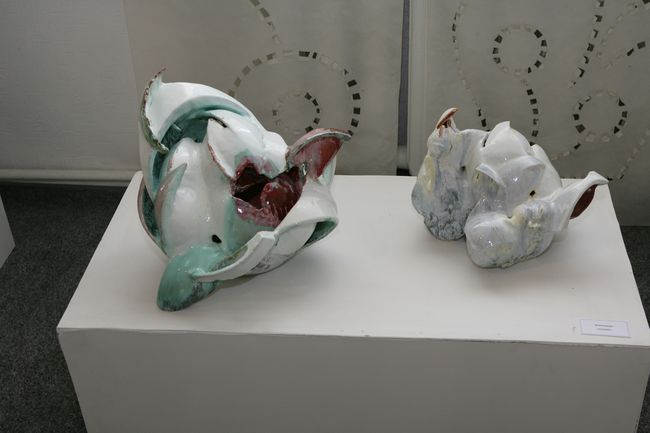Modern, talented, creative
A Biennale of Ceramics is held in Opishne near Poltava
The Ukrainian Biennale of Ceramics, launched in 2017 by the National Museum-Reserve of Ukrainian Pottery in Opishne near Poltava is one of the most significant events in Ukraine’s contemporary culture and decorative art in particular. Among other things, the biennale aims at representing and promoting talented ceramic artists, first of all, their new generation.
Yet the true spiritual revival of Opishne began under independent Ukraine, when in November 1986 the Pottery Museum was founded. In 1989 it was granted the status of the State Museum-Reserve of Ukrainian Pottery, and since 2001 it has held the status of a national museum. We raise our hat to the founder and director general of the museum, Oles Poshyvailo, Ph.D. in history, whose contribution to the establishment and further development of this institution is priceless. Moreover, in Opishne in 2013 Poshyvailo created the Museum of the Krychevsky Family, to commemorate the 140th birthday anniversary of Vasyl Krychevsky (1873-1952), an outstanding painter, graphic artist, applied artist, the founder of Ukrainian modern style in architecture of the early 20th century, who designed Ukraine’s state symbol, the trident, and whose academic titles will take too much room to list. The museum occupies the former pottery atelier in Opishne, built in 1916 and designed by architect Vasyl Krychevsky and ceramist, technologist Yurii Lebishchak. This fine specimen of Ukrainian modern architecture was literally raised from the ruins by the museum staff. It is noteworthy that Krychevsky’s descendants in the US have appreciated the act of the museum staff from Opishne and thanked them by adding a lot of artifacts to the museum’s collection.

Olha BEZPALKIV (Lviv), Unstable Equilibrium, Grand Prix
The selection of participants for the biennale took place last summer by the jurors’ secret vote. Out of 125 works by 65 applicants 105 works by 59 Ukrainian artists were selected. The awarding ceremony was held at the Center for Development of Non-Material Culture in Opishne, at the formal opening of the exhibit of all the biennale participants. The event will take place till March 2018.
An extensive exposition of works at the biennale shows that all the participating artists are extremely talented. For them pottery, which dates back to the dawn of human civilization, became a boundless field for technological experimenting, quest for new forms, harmonious combination of archaic and contemporary images, and search for expressive means of graphic art, painting, and sculpture which are acceptable in ceramic art. In other words, today ceramic art is the territory of free artistic exploration, and the complex transformations one can observe here could only be compared to the avant-garde innovations of the early 20th century.

Oleksandr MIROSHNYCHENKO (Kochetok, Kharkiv oblast), Without a name, Gold Award
The 2000s are a period when the art of professional ceramic art (the branch for potters with academic artistic education, as distinct from traditional artists) is dominated by fans of conceptual art. The jury was to a certain extent more in favor of such works, where the authorial concept comes first, and where the author’s individual manner of work with the material is the brightest.
The Grand Prix was awarded to a highly esthetic, minimalistic in design composition by Olha Bezpalkiv (Lviv) with images and title that are symbolic for Ukraine’s contemporary state: Unstable Equilibrium.
Nowadays a ceramic artist, who is often still conventionally referred to as applied artist, is first and foremost a philosopher. Their imagery often suggests a world of dramatic collisions, where plastic expression is often worlds apart from the conventional standards of beauty, and sometimes is even perceived as a dissonance. The work by Oleksandr Miroshnychenko from Kochetok near Kharkiv, winner of the gold award, inspired by the theme of war and its victims, painful for Ukrainians, is a proof.

Anatolii SHKURPELA (Opishne, Poltava oblast), candlestick Renaissance, Bronze Award
The Biennale shows that Ukrainian authorial (or artistic) ceramic art of the 2010s is to a large extent the art of abstract and associative images, among which the jury handpicked Iryna Marko’s Peonies, which got the silver award.
Obviously, professional ceramic art is not more sublime (or base) than traditional ceramic art. They are simply different as to their nature, and they cannot develop according to the same laws. The masterly executed bronze-winning Renaissance candlestick by the traditional potter Anatolii Shkurpela (Opishne) illustrates the perfectness of technique.
The future of the Ukrainian Biennale of Ceramics looks very bright and promising.
Zoia Chehusova is honored art worker of Ukraine
WINNERS
Olha BEZPALKIV (Lviv), Unstable Equilibrium, Grand Prix
Oleksandr MIROSHNYCHENKO (Kochetok, Kharkiv oblast), Without a name, Gold Award
Iryna MARKO (Lviv), Peonies, Silver Award
Anatolii SHKURPELA (Opishne, Poltava oblast), candlestick Renaissance, Bronze Award
Newspaper output №:
№76, (2017)Section
Culture





